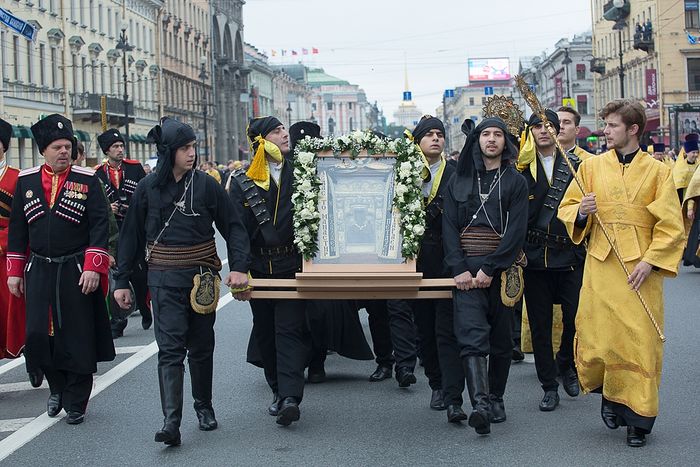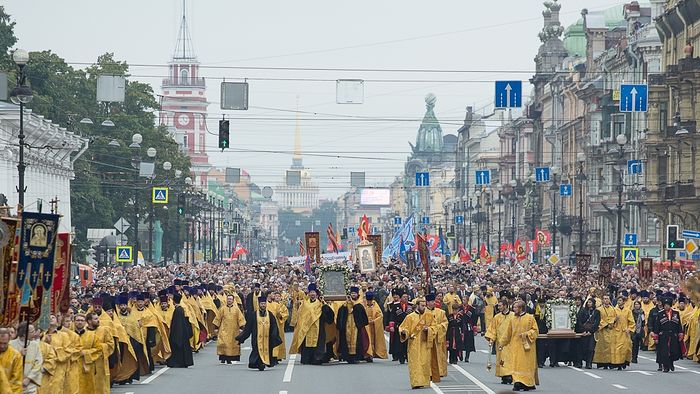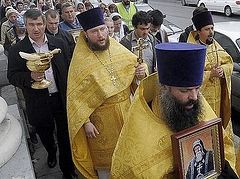St. Petersburg, September 12, 2017
Nearly 100,000 faithful took part in a cross procession today in St. Petersburg in honor of today’s feast of the Translation of the Relics of St. Alexander Nevsky, which are kept in the city’s St. Alexander Nevsky Lavra, reports RIA-Novosti.
The day’s celebrations began with the Divine Liturgy celebrated by Metropolitan Barsanuphius of St. Petersburg and Ladoga in the famous Kazan Cathedral, assisted by Metropolitan Panteleimon (Kalpakidis) of Veria of the Church of Greece, and several other hierarchs of the Russian Church, reports the site of the St. Petersburg Diocese.
Following the Divine Liturgy, the procession moved along Nevsky Avenue from the Kazan Cathedral to Alexander Nevsky Square.
“The procession was held today for the fifth time. It’s a revival of St. Petersburg tradition. This year the cross procession was headed by the ruling hierarch, Metropolitan Barsanuphius of St. Petersburg and Ladoga. In addition to the wonderworking Kazan Icon of the Mother of God, the revered Greek Panagia Soumela Icon of the Mother of God was carried at the head of the procession,” said archdiocesan communications head Natalia Rodomanova.
The Panagia Soumela icon, by tradition painted by the hand of St. Luke the Evangelist, was brought by the Greek delegation headed by Met. Panteleimon of Veria early Monday morning. The Greek clergy will participate in all festivities dedicated to the day of the heavenly patron of the city, St. Alexander Nevsky. After the procession, the miraculous Greek icon was placed in the Transfiguration Cathedral, where it will be available to the faithful for veneration until September 18.
The Divine Liturgy was also celebrated early in the day in the Holy Trinity Cathedral of the St. Alexander Nevsky Cathedral, where the relics of the great saint are housed, by the monastery’s deputy abbot Bishop Nazary of Kronstadt, Bishop Mstislav of Tikhvin, and the brotherhood clergy. Following the Liturgy, the relics of St. Alexander were carried out of the cathedral to the square outside of the lavra where the procession from the Kazan Cathedral came to an end. A moleben was served on the square before the relics of the right-believing prince by Met. Barsanuphius.
The St. Petersburg hierarch also offered a homily following the moleben in which he stressed that the example of the right-believing prince St. Alexander Nevsky is particularly important in this year of the centenary of the tragic events that shook the country in 1917, when the new communist “ideal” of a man who would change the world through his own strength rather than through the grace of God was promulgated. St. Alexander, on the other hand, was a great ruler, statesmen, and warrior, and yet entrusted himself wholly to the protection of God, even taking monastic vows before his death. The archbishop wished all gathered to be inspired by the life of St. Alexander “to grow in faith and oneness of mind, working for the good of the Fatherland and our hometown with diligence and sacrifice.”
“According to tentative estimates, about 100,000 people participated in the cross procession—not only residents of St. Petersburg, but also guests from various regions of Russia, and also the Greek delegation,” Rodomanova stated.
St. Alexander Nevsky’s relics were transferred from Vladimir to St. Petersburg on September 12, 1724 by order of Tsar Peter I. Empress Elizabeth established a city-wide cross procession on September 12 in 1743 which was interrupted in the Soviet years, but revived in 2013 during the celebration of the 300th anniversary of the St. Alexander Nevsky Lavra.





